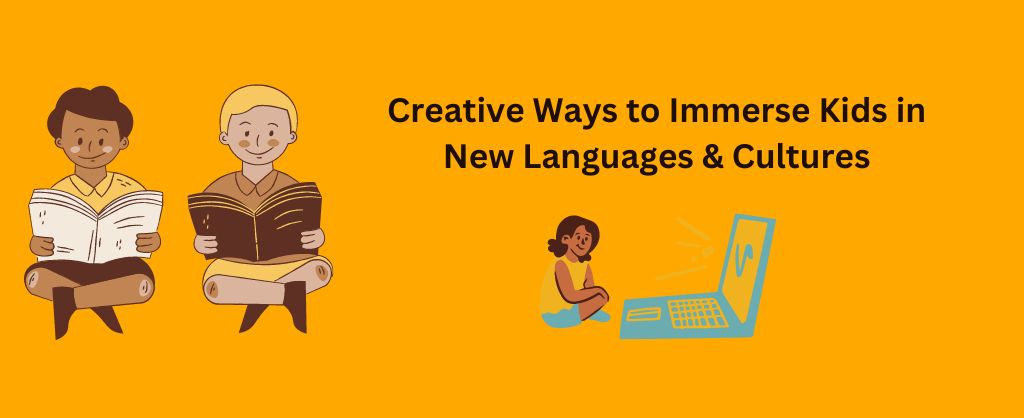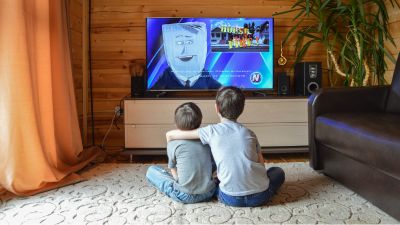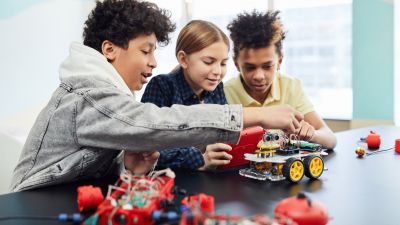15 Creative Ways to Immerse Kids in New Languages & Cultures

Learning a new language or about a different culture can be tough, especially for kids. But making it fun and part of their everyday life helps it stick better.
However, immersing kids in the language and culture makes the process more engaging, interactive, and effective.
Here are 15 creative ideas to fully immerse kids in a new language
Introducing children to new languages and cultures during their formative years provides lifelong benefits. Immersion in diversity develops adaptability, problem-solving, open-mindedness and empathy.
The key is to make language and culture exploration interactive, easy and fun!
1. Watch Cartoons and Movies
Watching movies, cartoons, shows or listening to audiobooks in a foreign language surrounds kids with native speakers and real linguistic contexts.
They’ll pick up common words and phrases quickly from hearing them repeatedly. Put on subtitles in your native language at first to reinforce vocabulary meanings.
Discuss what they watched and encourage kids to imitate words and phrases. Visual stories engage kids in language and make it stick.
2. Play Music All the Time
Have upbeat music from other cultures playing around the house and in the car. Kids naturally love music, so surrounding them with fun melodies and rhythms makes language learning subconscious yet effective.
Look up lyrics together and have kids memorize and sing along with choruses. Music fills their minds with pronunciation, cadence and emotion of the language.
3. Cook Traditional Dishes
Cooking authentic cultural recipes at home is a flavorful way to immerse kids in traditions from around the world.
Find kid-friendly recipes from the culture and cook them together. Teach kids the names of ingredients and foods as you go.
Over meals, discuss the cultural significance of what you made and how it relates to celebrations or values. The sensory experience of preparing and tasting traditional dishes forges deeper connections with culture.
4. Attend Local Cultural Events
Seek out cultural events in your community like festivals, markets, parades, exhibits and shows where your kids can be immersed in traditional music, food, crafts and performances.
Let them interact with locals by purchasing items, viewing displays, trying activities and listening to stories. Experiencing cultural celebrations first-hand brings language and heritage to life.
5. Visit Ethnic Neighborhoods or Shops
Make regular excursions with your kids to immerse yourselves in ethnic districts and specialty grocery stores and restaurants where you can use the language in real situations.
Let kids order their own food, have casual conversations with staff, and take in the unique cultural elements around them.
This exposure helps language flourish.
6. Read Folk Tales and Stories
Reading culturally-relevant stories, fables and literature helps language skills grow within an engaging, meaningful context. Choose tales that align with kids’ ages and interest levels.
Discuss the plots, characters, lessons and historical insights. Make connections between key phrases and overall meanings. Stories weave together language learning with cultural perspectives.
7. Watch Language Learning Shows
Seek out entertaining television shows, web series, YouTube channels or streaming programs designed specifically to teach kids foreign languages. Combine viewing with hands-on games and activities.
Use repetition, pause and discussion to reinforce new vocabulary and phrases. Visual language shows tailored to kids provide repetition without feeling like study.
8. Display Diverse Cultural Décor
Decorate kids’ living spaces with wall hangings, bedding, artwork, flags, maps and other decorative items featuring words, phrases, alphabets and imagery from other cultures.
Surrounding kids with language and cultural artifacts helps these representations feel familiar, piquing curiosity about their meanings.
9. Listen to Language Learning Music
In addition to popular music, introduce kids to children’s music that focuses specifically on teaching foreign vocabulary and phrases.
Many kids’ language learning artists make catchy, songs that get stuck in kids’ heads – planting seeds for language skills. Songs keep language learning feeling more like play.
10. Host Language Play Dates
Arrange get-togethers for your kids with friend who are native speakers of the language you want to reinforce.
During play dates, encourage the use of that language as much as possible through games, activities, meals or acting out stories.
Interactions with peers allow kids to use the language in a relaxed, natural way.
11. Video Chat with Native Speakers
Set up video calls between your kids and relatives, friends or language tutors who speak the language natively.
Practicing conversational skills like greetings, asking questions and sharing interests allows kids to immerse themselves in the rhythms, tones and pacing of real dialogue.
The personal connections make language learning engaging.
12. Check Out Diverse Books from the Library
Libraries offer a wealth of foreign language learning resources. Let your kids pick out children’s books, movies and music in languages they want to further explore.
Use literacy programs, cultural events and language groups at your library to expand interactive learning. Libraries make exploration easy.
13. Take Field Trips to Cultural Centers
Visit cultural centers, embassies, museums and heritage sites where your kids can engage with history, traditions and arts through exhibits and hands-on programs.
Friendly cultural center staff can provide insider perspectives. Tours, classes and workshops bring language to life.
14. Role Play Everyday Conversations
Practice common conversations and scenarios through role play like greeting people, ordering food, introducing themselves, asking for help, or making purchases.
Use props and get silly with accents. Role playing builds confidence and gives context for how vocabulary and phrases are used in real situations, so kids can converse appropriately.
15. Label Items Around the House
Use sticky notes to label furniture, appliances, play items, foods and other everyday objects around your home with vocabulary words in the language you want kids to learn.
Seeing the foreign words linked to concrete items they know builds instinctive mental associations. Home labeling surrounds kids with language.
Conclusion
Immersing kids in languages and cultures works best when activities are woven seamlessly into everyday routines, media and playtime.
An immersive approach makes language learning subconscious yet constant.
With plenty of fun exposure through interactive activities, languages and cultural diversity become an integral part of kids’ lives and development.
Get creative and make it playful – happy language learning!













